About the NEP
How NEP works
The National Evaluation Platform is built through a cycle-based approach that progressively adds new types of data, analytical tools and communications skills. These skills compose the NEP Toolbox - a suite of evaluation and communication tools which help NEP country teams produce and disseminate MNCH&N findings to policymakers.
The NEP Cycle
WHY NEP?
Countries face program and policy challenges
To accelerate progress on women’s and children’s health, countries need stronger program evaluation and planning processes that assess what works and what doesn’t. But evaluations have become increasingly difficult due to a crowded implementation landscape, confounding contextual factors, and insufficient donor commitment and investment. Important data sets are separately maintained, inconsistently formatted, and incompletely available for analysis and decision-making.
Many countries face challenges in managing and analyzing health, nutrition, and contextual data from multiple sources, leaving decision-makers without the critical information they need to make strategic, evidence-based decisions.
Governments also need to demonstrate their fulfillment of program and policy commitments through accurate, timely reporting on key maternal, newborn, and child health and nutrition (MNCH&N) indicators that are tracked in national and international accountability frameworks.
NEP Offers Solutions
NEP applies rigorous analytical methods to assess the impact of programs and strategies, allowing assessment of contextual factors that may affect program implementation and results and identification of populations that are not being reached by key interventions. NEP analyses provide a data-driven view of what is working and why, so decision-makers can identify successful programs appropriate for scale-up and base investment decisions on objective evidence of need and intervention effectiveness.
NEP’s continuous evaluation process strengthens programs from start to finish. Programs are assessed within their complex, multi-sectoral contexts, so program “silos” are broken down and services can be more strategically and effectively integrated. More comprehensive data and analyses enable program planners to identify unreached populations, and to make adjustments based on the most recent evidence. Program monitoring and results data are available for further analysis through a central platform, so successful projects are more likely to be scaled up and replicated. Countries and donors can base investment decisions on objective evidence of need and intervention effectiveness. NEP empowers decision-makers to use strong, objective foundation of evidence for strategic program and policy planning.


